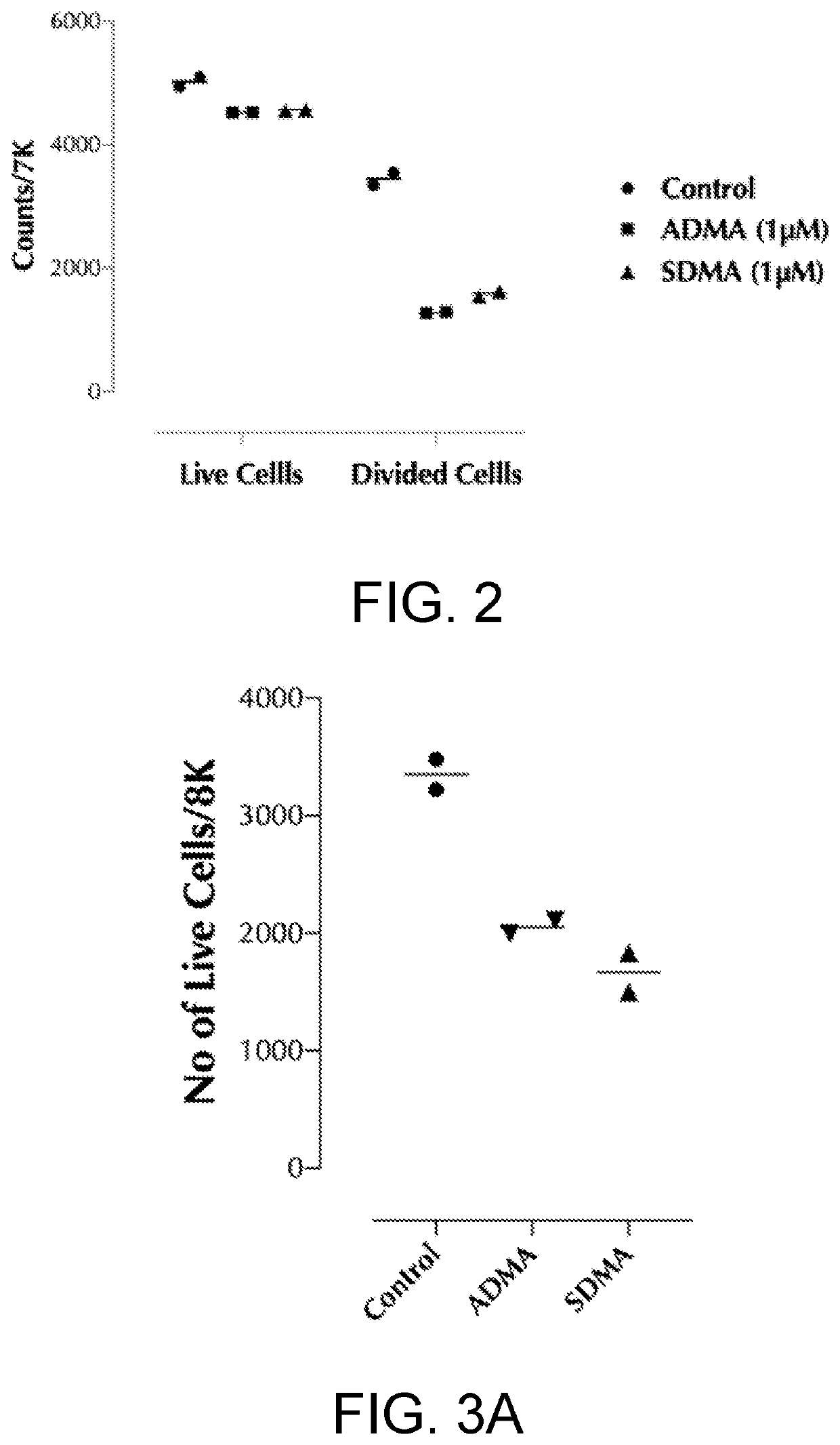Method of inhibiting the proliferation of t and/or b lymphocytes via dimethylarginine derivatives and lymphocytes proliferation inhibitor
a technology of dimethylarginine derivatives and inhibitors, which is applied in the field of immunotherapy, can solve the problems of complicated mechanisms of autoimmune diseases and the method of life-long treatment, and achieve the effect of effectively treating arthritis and effectively treating diseases
- Summary
- Abstract
- Description
- Claims
- Application Information
AI Technical Summary
Benefits of technology
Problems solved by technology
Method used
Image
Examples
embodiment 1
ADMA and SDMA Inhibit Mouse T Cell Proliferation
[0060]Step 1. Mouse T Cells Isolation
[0061]Total splenic T cells were isolated by StemCell isolation kit: From female 6-8 weeks old C57BL mice, spleens were harvested, mechanically disrupted, and incubated with a biotinylated antibody cocktail consisting of antibodies to B220, CD11b, CD11c, CD16 / 32, CD19, CD25, CD105, NK1.1, and TCRγδ (StemCell). After a wash step, cells were incubated with streptavidin-coated magnetic nanoparticles (StemCell). CD3+ cells were then isolated by applying a magnetic field and collecting the unbound cells.
[0062]Step 2. Inhibition of ADMA and SDMA on Mouse T Cells Proliferation
[0063]The total T cells obtained in step 1 were labeled with the proliferation indicator dye CellTrace Violet according to the manufacturer's protocol, and then seeded in 96-well round bottom cell culture plates at 2×105 per well, next the cells were stimulated with anti-CD3 and anti-CD28 antibody coated magnetic beads (Gibco Dynabead...
embodiment 2
ADMA and SDMA Inhibit Human T Cells Proliferation
[0066]Human T cell isolation and in vitro proliferation experiments: the use of blood from healthy adult blood donors was approved by the Ethics Committee of the Medical Faculty of Guangzhou Medical University, Guangzhou, China. Peripheral blood mononuclear cells (PBMCs) were isolated using Sepmate PBMC isolation tubes following the manufacturer's instructions (StemCell). CD3+ human T cells were positively isolated by magnetic cell sorting (Miltenyi Biotec, Bergisch-Gladbach, Germany). Purified T cells were labeled with the proliferation dye CellTrace Violet according to the manufacturer's protocol. Then the cells (1×105 cells per well in flat bottom 96 well plate) were stimulated in vitro with immobilized anti-CD3 (5 μg / ml) and anti-CD28 (2 μg / ml) antibody (Biolegend, San Diego, USA), and expanded in RPMI1640 medium up to 5 days. Dilution of CellTrace Violet, indicating proliferation, was then evaluated by flow cytometry.
[0067]The ex...
embodiment 3
ADMA and SDMA Inhibit Mouse B Cells Proliferation
[0068]Step 1. Isolation of Total Splenocytes
[0069]Spleens were harvested, mechanically disrupted, and resuspend in RPMI 1640 complete medium (10% FBS).
[0070]Step 2. B Cells Proliferation Assay
[0071]Total splenocytes were then labeled with the proliferation dye CellTrace Violet according to the manufacturer's protocol. Then splenocytes (1×105 cells per well in flat bottom 96 well plate) were stimulated with recombinant human IL-4 (1 Ong / me and α-mouse IgM (10 μg / ml), and expanded in RPMI1640 medium up to 5 days. Dilution of CellTrace Violet was then evaluated by flow cytometry. (Note; splenocytes contain T cells and monocytes, which will die off during the assay period.)
[0072]Experimental group: ADMA or SDMA (5 μM) was added (ADMA and SDMA dissolved in sterile endotoxin-free water, the storage solution concentration is 0.5 mM). Control group: the same volume of sterile endotoxin-free water without ADMA or SDMA was added.
[0073]The exper...
PUM
| Property | Measurement | Unit |
|---|---|---|
| Molar density | aaaaa | aaaaa |
| Molar density | aaaaa | aaaaa |
| Concentration | aaaaa | aaaaa |
Abstract
Description
Claims
Application Information
 Login to View More
Login to View More - R&D
- Intellectual Property
- Life Sciences
- Materials
- Tech Scout
- Unparalleled Data Quality
- Higher Quality Content
- 60% Fewer Hallucinations
Browse by: Latest US Patents, China's latest patents, Technical Efficacy Thesaurus, Application Domain, Technology Topic, Popular Technical Reports.
© 2025 PatSnap. All rights reserved.Legal|Privacy policy|Modern Slavery Act Transparency Statement|Sitemap|About US| Contact US: help@patsnap.com



